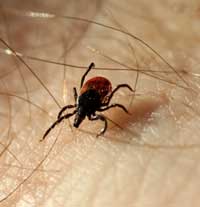|

 Human disease: Hard ticks can transmit human diseases such as relapsing fever,
Lyme disease, Rocky Mountain spotted fever, tularemia, equine encephalitis
and several forms of ehrlichiosis. Additionally, they are responsible
for transmitting livestock diseases, including babesiosis and anaplasmosis. Human disease: Hard ticks can transmit human diseases such as relapsing fever,
Lyme disease, Rocky Mountain spotted fever, tularemia, equine encephalitis
and several forms of ehrlichiosis. Additionally, they are responsible
for transmitting livestock diseases, including babesiosis and anaplasmosis.
Habitat: Ticks are often found in tall grass, where they will rest themselves
at the tip of a blade so as to attach themselves to a passing animal
or human. It is a common misconception that the tick can jump from
the plant onto the host. Physical contact is the only method of
transportation for ticks. They will generally drop off of the animal
when full, but this may take several days. Ticks contain a structure
in their mouth area that allows them to anchor themselves firmly
in place while sucking blood. Pulling a tick out forcefully may
squeeze contents of the tick back into the bite and often leaves
the mouthpiece behind, which may result in infection.
Eggs: Eggs laid by an adult female deer tick in the spring hatch into
larvae later in the summer. These larvae reach their peak activity
in August. No bigger than a newsprinted period, a larva will wait
on the ground until a small mammal or bird brushes up against it.
The larva then attaches itself to its host, begins feeding, and
engorges with blood over several days.
Lyme disease: If the host is already infected with the Lyme disease spirochete
from previous tick bites, the larva will likely become infected
as well. In this way, infected hosts in the wild serve as spirochete
reservoirs, infecting ticks that feed upon them. Other mammals and
ground-feeding birds may also serve as reservoirs.
Most larvae, after feeding, drop off their hosts and molt, or transform,
into nymphs in the fall. The nymphs can remain active throughout
the winter and early spring.
Nymphs: In May, host-seeking nymphs wait on vegetation near the ground
for a small mammal or bird to approach. The nymph will then latch
on to its host and feed for 4 or 5 days, engorging with blood and
swelling to many times its original size. If previously infected
during its larval stage, the nymph may transmit the Lyme disease
spirochete to its host. If not previously infected, the nymph may
become infected if its host carries the Lyme disease spirochete
from previous infectious tick bites.
Human hosts: Too often, humans are the hosts that come into contact with infected
nymphs during their peak spring and summer activity. Although the
nymphs' preferred hosts are small mammals and birds, humans and
their pets are suitable substitutes. Because nymphs are about the
size of a poppy seed, they often go unnoticed until fully engorged,
and are therefore responsible for the majority of human Lyme disease
cases.
Engorged nymph: Once engorged, the nymph drops off its host into the leaf litter
and molts into an adult. These adults actively seek new hosts throughout
the fall, waiting up to 3 feet above the ground on stalks of grass
or leaf tips to latch onto deer (its preferred host) or other larger
mammals (including humans, dogs, cats, horses, and other domestic
animals). Peak activity for adult deer ticks occurs in late October
and early November.
Winter: As winter closes in, adult ticks unsuccessful in finding hosts
take cover under leaf litter or other surface vegetation, becoming
inactive when covered by ice and snow. Generally, winters in the
northeast and upper mid-west are cold enough to keep adult ticks
at bay until late February or early March but not when temperatures
begin to rise. At this time, they resume the quest for hosts in
a last-ditch effort to obtain a blood meal allowing them to mate
and reproduce.

Adult female ticks that attach to deer, whether in the fall or spring,
feed for approximately one week. Males feed only intermittently.
Mating may take place on or off the host, and is required for the
female's successful completion of the blood meal. The females then
drop off the host, become gravid, lay their eggs underneath leaf
litter in early spring, and die. Each female lays approximately
3,000 eggs. The eggs hatch later in the summer, beginning the two-year
cycle anew.
All text is available under the terms
of the GNU Free Documentation License
|